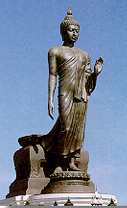
Phra Pathom Chedi

Buddha image, Phuttha Monthon
|
Nakhon Pathom, only 56 kilometers west of Bangkok, is a city dating back to at least 150 B.C., say the historians...a city rich with meaning to all Buddhists as it was here Buddhism was first introduced to the country now known as Thailand.
Phra Pathom Chedi, on coming toward the city, the first glimpse of towering Phra Pathom Chedi is over powering. It is one of the largest Chedis in the world and in Thailand, by far the most holy of all Buddhist structures. Reaching to sky for just half and inch less than 380 feet, the dome shines like pure gold in the sunlight.
The highly glazed tiles covering the dome are golden brown in color and were brought from China.
At the four points of the compass in the outer courtyyard are four Viharas (halls) containing image of Buddha in various postures. The Eastern Vihara shows the image of Buddha beneath a delicately painted. Pho tree which covers the entire wall behind the image and is very unusual. The inter room is a Royal Chapel containing an altar where the King pays homage.
The Southern Vihara shows the image of Buddha protected by a serpent. The Western Vihara contains the image of Buddha in a reclining position, just before his death, surrounded by disciples, and an inner room contains yet another reclining image. The Northern Vihara, directly infront of the entrance and across from the frame building where the guides are located, contains a standing image Buddha. The ashes of King Vajiravudh are buried at the base of this image.
|



